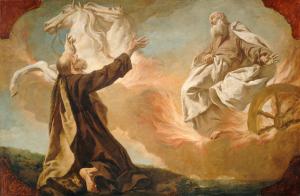Elisha was a biblical prophet and successor to the prophet Elijah. According to the Jewish Virtual Library (“Elisha”), he lived in the 9th century BC. His story can be found in the Bible starting with 1 Kings 19, and then 2 Kings, chapters 2-9, and 13. The Bible indicates (1 Kings 19:16 and 2 Kings 3) that he was anointed near the end of wicked King Ahab‘s reign [c. 875-853 BC], and began his ministry at the beginning of the reign of King Joram [aka Jehoram] [c. 852-841].
Shalmaneser III of Assyria wrote about a battle in 853 BC in which he defeated an alliance of a dozen kings — including Ahab — in the Battle of Qarqar. This was recorded on the Kurkh Monoliths, discovered in 1861. Ahab is also mentioned outside the Bible on the inscriptions of the Mesha Stele from Moab (dated c. 840 BC). Likewise, Jehoram is extra-biblically attested in the Tel Dan Stele (dated 870-750 BC).
Elisha was from Abel-Meholah (1 Ki 19:16). Archaeologists aren’t exactly sure of its location, but they believe that they have likely identified its general area in ancient Israel, near the Jordan River, south of the Sea of Galilee.
In 2013, at Tel Rehov, in this region, a potsherd was discovered by the prominent Israeli archaeologist (of impeccable reputation), Amihai Mazar, professor at the Institute of Archaeology of the Hebrew University of Jerusalem. An article from Watch Jerusalem (3-21-19) summarizes the find:
A shard of pottery was discovered with ancient text written on it in red ink. The shard, along with the layer within which it was found, was dated to the middle-ninth century b.c.e. The ancient Hebrew script was damaged, yet still could be translated with virtually complete certainty as the name “Elisha.” See below [illustration]: . . .
Not only does the name parallel the biblical prophet, it also dates to the same time period that he lived. And it was found in an area where he spent much of his time (he was born only seven miles away, in a town named Abel-Meholah). The Bible states that Elisha spent so much time in this area, that a couple living in nearby Shunem were inspired to make a chamber in their house for him to stay in (2 Kings 4).
Additionally, an inscription bearing the name “Nimshi” was found nearby (as well as a second “Nimshi” inscription five miles away). Elisha told one of his disciples to go and anoint as king a man named Jehu, specifically telling him that Jehu [r. c. 842-815 BC] was a descendant of Nimshi (2 Kings 9:1-3). So this name had significance to Elisha’s record.
Added to this ancillary evidence is the simple fact that, based on current knowledge, the name “Elisha” was quite rare in ancient Israel—thus, the chances of this being the prophet are even higher. (“The Biblical Prophets: Archaeological Evidence?”, by Christopher Eames)
Archaeologist Stephen Pfann stated:
With only six other people by the name of Elisha known in that time for a couple of centuries on either side, we can somehow believe that either there was just the luck that this holy man was also by the name of Elisha, or this was Elisha the prophet himself . . . (“Archeologists Believe They Have Proof for the Prophet Elisha”, International Christian Embassy Jerusalem, 7-25-13)
Dr. Mazar himself described the find:
I cannot say for sure this particular Elisha that we found is the biblical Elisha. “You know it’s very difficult to say, but it is very tempting because it is exactly the period when Elisha acted — the second half of the 9th century BC. (Ibid.)
Shunem, or Shunaam (2 Ki 4:8), about 12-13 miles southwest of the Sea of Galilee, is where Elisha raised a boy from the dead (2 Ki 4:32-37). Tel Rehov is more directly south of the Sea of Galilee: about 15 miles away. Dothan is identified as a place visited by Elisha (2 Ki 6:13). It’s about 25 miles southwest of the Sea of Galilee. Archaeologists agree that Tel Dothan is the location of ancient Dothan. Most of the archaeological artifacts found there date from the time of Elisha.
***
Practical Matters: Perhaps some of my 4,000+ free online articles (the most comprehensive “one-stop” Catholic apologetics site) or fifty books have helped you (by God’s grace) to decide to become Catholic or to return to the Church, or better understand some doctrines and why we believe them.
Or you may believe my work is worthy to support for the purpose of apologetics and evangelism in general. If so, please seriously consider a much-needed financial contribution. I’m always in need of more funds: especially monthly support. “The laborer is worthy of his wages” (1 Tim 5:18, NKJV). 1 December 2021 was my 20th anniversary as a full-time Catholic apologist, and February 2022 marked the 25th anniversary of my blog.
PayPal donations are the easiest: just send to my email address: [email protected]. You’ll see the term “Catholic Used Book Service”, which is my old side-business. To learn about the different methods of contributing, including 100% tax deduction, etc., see my page: About Catholic Apologist Dave Armstrong / Donation Information. Thanks a million from the bottom of my heart!
***
Photo credit: Elijah Taken Up in a Chariot of Fire [Elisha watching], by Giuseppe Angeli (1712-1798) [public domain / National Gallery of Art]
***
Summary: Archaeological evidence exists for the historicity of the prophet Elisha, who lived in the 9th century BC: as well as for two kings & another person of his time period.














